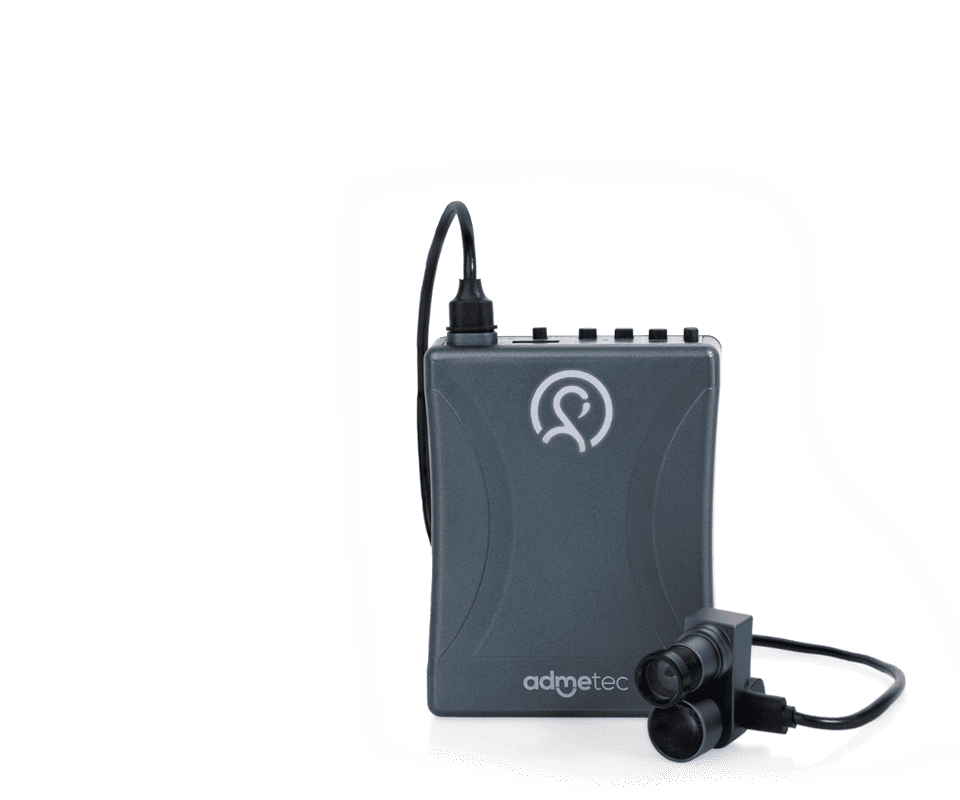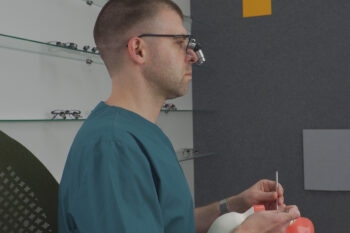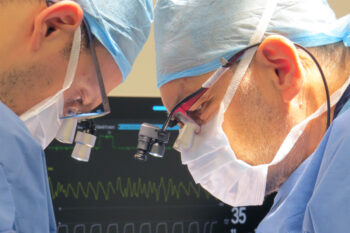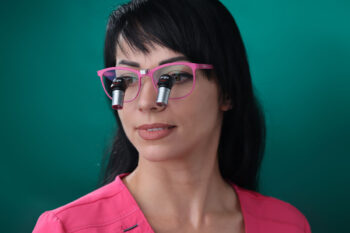Magnification loupes are becoming an integral part of dentistry, with dental students increasingly required to adopt and learn how to use them. Historically, limited choice and cost concerns have made selecting beginners’ loupes somewhat of a given.
However, recent years have seen an evolution in loupes, resulting in new technologies and more variety than previously available. Let’s explore the latest versions and draw comparisons to legacy types to help you make the most informed decisions possible.
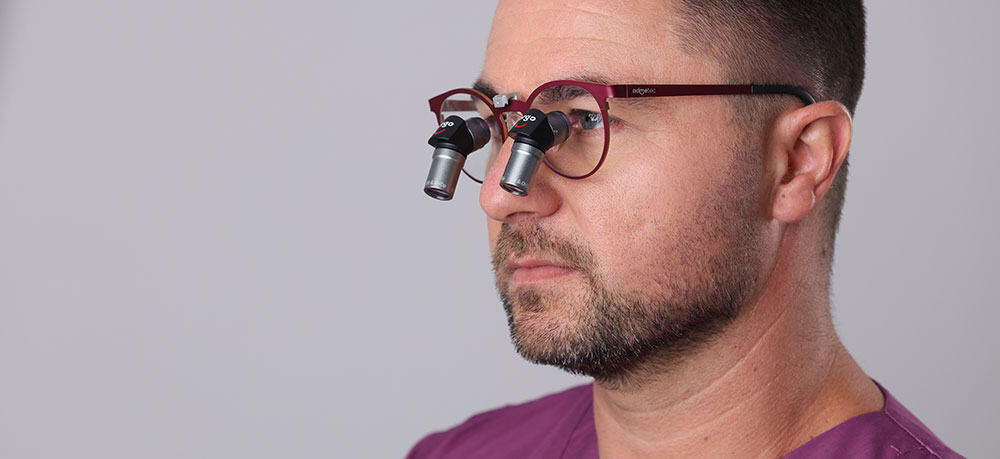
Ergonomic Loupes
Through-the-lens (TTL) loupes have traditionally divided into two categories: Galilean loupes (Fig. 1) and prismatic (also called Keplerian) loupes (Fig. 2). Ergonomic loupes (Fig. 3) are a third, relatively new category of TTL loupes. Sometimes these loupes are referred to as refractive or deflection loupes because of the types of optics used in their oculars.
Ergonomic loupes were developed, in part, to address a literal pain point of dentists—occupational chronic discomfort and pain because of straining, reaching and contorting during long hours in operatory settings. Work-related pain among dental practitioners is well-known and widespread. A study of 170 dentists in various specialties found that nearly three in four suffered from musculoskeletal pain.1 In fact, as many as one-third of dentists retire prematurely due to physical ailments.2
While the human body obviously enables bending and twisting, it is not designed to stay in a static, bent or contorted position for extended periods of time. Doing so creates stress and strain on joints and ligaments, leading to microtraumas, similar to carpal tunnel syndrome or tennis elbow, that develop faster than the body can heal. The resulting cumulative trauma can cause chronic occupational pain.
Adopting a posture that works with the natural, biomechanical design of the body protects health over time and reduces the risk of occupational chronic pain. For those already in pain, adopting a healthy, ergonomic posture addresses the cause of the problem, enabling the body to heal (or at least not create new trauma). For those not yet in pain, an ergonomic posture is a type of preventive medicine—the same as maintaining oral health to avoid developing problems later.
A point of distinction: Historically, many new dental loupes have been dubbed “ergonomic” because they improve, at least somewhat, a practitioner’s posture, diminishing physical strain and contortion while treating patients. However, in just the past few years, deflection loupes have been introduced that for the first time offer the possibility of a fully ergonomic working position. The practitioner no longer needs to bend and contort to see inside the patient’s mouth, instead relying on the loupes for proper viewing angles.
Magnification in general
First-time users have been traditionally advised to adopt low-magnification Galilean loupes because of their wide field of view and large depth of field. These features make the loupes easy to use over a wide range of procedures. As a bonus, such loupes generally don’t need to be exactingly customized to be adequately functional in the operatory.
But again, times change. Considering established challenges and recent technologies, it’s worth asking whether traditional Galilean loupes are still the best choice. While no one-size-fits-all answer exists, an honest look at the multiple factors that must be considered toward an educated decision is certainly in order.
First and foremost, of course, is relevant, procedure-appropriate magnification. And while all dentists have different working styles and magnification “Goldilocks zones,” there are certainly loose correlations pertaining to specific operatory settings. When compared with conventional loupes, ergonomic loupes use slightly higher magnification for essentially the same level of image enhancement, because sitting upright leaves practitioners a bit farther away from patients.
- For example, a pedodontist would have good reason to go for a low- to mid-range magnification, such as a Galilean 2.7x or ergonomic loupes with 3x. Kids move a lot, and the wider field of view available with these magnifications make it easier to maintain focus for fidgety patients.
- First-time periodontists and oral surgeons also tend to skew lower on the magnification chart, although many who’ve grown accustomed to loupes might prefer to adopt higher, 5x magnification ergonomic loupes. Orthodontists are typically in the 3x–5x range; hygienists usually max out around 4x.
- Concentrations where high magnification is common include restoration specialists, who tend to thrive in the 5x–7.5x range, and endodontists, who may use ergonomic loupes as powerful as 10x, especially if they’re accustomed to also working with microscopes.
Meanwhile, those learning general dentistry and those yet to choose a dedicated dental niche typically require a wider field of view while learning new procedures and adapting to working with loupes. For this reason, it’s logical to choose lower magnification power, which grants improved detail-vision while still conveying the “big picture.” As magnification increases in intensity, more details are revealed but less of the picture becomes visible. Subsequently, higher magnifications are more appropriate for experienced practitioners focusing on very specific aspects of the mouth.
As students gain experience—and particularly after choosing a field of expertise—it usually makes sense to increase loupes magnification. Often, doctors who increase magnification are surprised to see the amount of detail the higher magnification reveals—a sort of “I can’t believe what I’ve been missing” effect. Still, magnification needs vary, depending on the type of work being done and the practitioner’s own preferences. Even different practitioners working in the same field of expertise will feel differently about the width of field and depth of detail they want to see. The best rule of thumb is to see for yourself.
Other variables to weigh
Once a dentist’s desired magnification comes into focus, other factors enter the picture:
Weight. When it comes to loupes, less is more. Weight is a key factor in the usability of tools that are worn on the face. Every ounce matters! Optics aside, a heavy configuration will cause increased tiredness, added stress and even headaches. The key is balancing quality and usability.
Customization. Stating larger declination angles is not akin to customization. For loupes to be truly specialized, they must consider working distance, unique facial features and personal preferences. The basic rule of thumb is that the more customized the loupes are, the better.
After-sales service. As with any high-leverage professional tool, adjustments and other issues can arise. Users should feel empowered to reach out for assistance, confident the provider has both the knowledge and patience to assist as needed.
Is changing loupes difficult?
Students and even experienced loupes users might feel reluctant to try refractive loupes. For some, after investing so much effort to learn the techniques of dentistry, the idea of learning a completely new technique can seem overwhelming, and the notion of operating on a patient using indirect vision can be intimidating. Experienced loupes users might be concerned about the time it takes to learn a new way of seeing, realizing that anything that slows down their fast-paced work can be a problem.
However, many of the concerns about switching loupes types may be overblown. For starters, switching to any new high-leverage professional tools will come with its inherent set of challenges. For some people, the adjustment period is faster than for others. But like riding a bike or swimming, once the new skill is learned, it’s learned forever. And considering the alternative may be a career of chronic pain, the ends seem to certainly justify the means.
Switches can be gradual – or even situation-dependent. Some doctors switch back and forth between ergonomic loupes and conventional loupes for purely logistical reasons – such as working in multiple clinics and leaving the old set in one while using the new set in the other. It is more common for doctors to have multiple magnifications of loupes due to the different procedures the doctor performs.
To make the transition to ergonomic loupes as smooth as possible, it is recommended to implement them gradually, using them only for parts of the day and/or for simple examinations and easier procedures before expanding their use to more complicated settings. It also can be helpful to “train the brain” by practicing with hand-eye coordination-dependent tasks outside the operatory. Such practice activities might include eating dinner or doing a crossword puzzle.
In conclusion, information is key to bringing students “into the loupe” in a way that addresses their clinical magnification needs as well as their long-term health, well-being, and career longevity.
Knowledge enables a balanced look at the pros and cons of the different options available. There is no “right” solution, there is the solution that is right for the individual practitioner but considering the newer, pain-preempting options now available it seems advisable for students (and their mentors) to sit up straight and listen, with the emphasis on sitting up straight.







